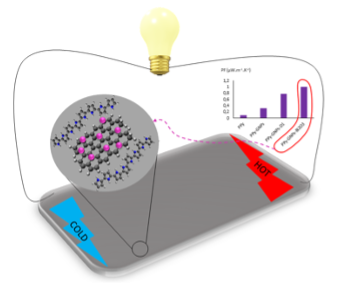-
Share this page
P3-Bourenane
Effect of decorated GNPs by bismuth oxide nanoparticles on the thermoelectric power factor of polypyrrole-based nanocomposites
Y. Bourenane Cherif 1, Z. Mekhalif 1, A. Mekki 2 and Z. Bekkar Djelloul Sayah 2
1 Laboratory of Chemistry and Electrochemistry of Surfaces, University of Namur, 61 Rue de Bruxelles, B – 5000 Namur, Belgium
2 Ecole Militaire Polytechnique, BP 17, Bordj El-Bahri, 16046, Alger, Algeria
Given the drawbacks of organic materials’ thermoelectric (TE) conversion efficiency, an approach has been made in this study to synthesize a hybrid organic-inorganic material based on polypyrrole (PPy), graphene nanoplatelets (GNPs) and bismuth oxide nanoparticles (Bi2O3). A simple and successful method of decorating GNPs with in-situ generated Bi2O3 nanoparticles was adopted utilizing infrared (IR) irradiation and diazonium chemistry. Functionalization, impregnation, and calcination are all steps in the decorating procedure. Nanocomposites were synthesized by a simple in-situ polymerization of pyrrole on decorated GNPs. To explore the structural and physical properties of the fillers and the nanocomposites, X-ray diffraction (XRD), Transmission electron microscopy (TEM), Raman spectrometer, Fourier transform infrared spectroscopy (FTIR), and X-ray photoelectron spectroscopy (XPS) were used. Thereby investigating the electrical conductivity ( �� ) and Seebeck coefficient (S) at room temperature, a promising improvement was observed in PPy/GNPs-Bi2O3 compared to pure PPy. This enhancement can be attributed to π–π stacking between PPy chains and GNPs surface, which is responsible for most materials’ remarkable electronic properties. Furthermore, Bi2O3 enhances the TE behavior of the nanocomposite by binding both components to improve charge transport. At room temperature, 11 times enhanced power factor (PF) of 1 µW.m-1.K-2 compared to pure PPy. This result could be explored at high temperatures and reach higher TE features.
Keywords: Diazonium chemistry, bismuth oxide, graphene, thermoelectric properties, polypyrrole

